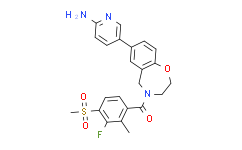| 中文名称: | XL388 促销 | ||||
|---|---|---|---|---|---|
| 英文名称: | XL388 | ||||
| 别名: | X-380 (7-(6-Aminopyridin-3-yl)-2,3-dihydrobenzo[f][1,4]oxazepin-4(5H)-yl)(3-fluoro-2-methyl-4-(methylsulfonyl)phenyl)methanone | ||||
| CAS No: | 1251156-08-7 | 分子式: | C23H22FN3O4S | 分子量: | 455.5 |
| CAS No: | 1251156-08-7 | ||||
| 分子式: | C23H22FN3O4S | ||||
| 分子量: | 455.5 | ||||
基本信息
|
产品编号: |
X10075 |
||||
|
产品名称: |
XL388 |
||||
|
CAS: |
1251156-08-7 |
储存条件 |
粉末 |
-20℃ |
四年 |
|
|
|
||||
|
分子式: |
溶于液体 |
-80℃ |
6个月 |
||
|
分子量: |
455.50 |
-20℃ |
1个月 |
||
|
化学名: |
(7-(6-Aminopyridin-3-yl)-2,3-dihydrobenzo[f][1,4]oxazepin-4(5H)-yl)(3-fluoro-2-methyl-4-(methylsulfonyl)phenyl)methanone |
||||
|
Solubility (25°C): |
|||||
|
体外:
|
DMSO |
1.25mg/mL (2.74mM) |
|||
|
Ethanol |
Insoluble |
||||
|
Water |
Insoluble |
||||
|
体内(现配现用): |
1.请依序添加每种溶剂:10% DMSO→40% PEG300→5% Tween-80→45% saline Solubility:≥2.5mg/mL(5.49mM);Clear solution |
||||
|
此方案可获得 ≥ 2.5 mg/mL (5.49mM,饱和度未知) 的澄清溶液。 以 1mL 工作液为例,取 100μL 25.0 mg/mL 的澄清 DMSO 储备液加到 400μL PEG300 中,混合均匀;向上述体系中加入50μL Tween-80,混合均匀;然后继续加入 450μL生理盐水定容至 1mL。 |
|||||
|
2.请依序添加每种溶剂:10% DMSO→90%(20% SBE-β-CD in saline) Solubility:≥2.5mg/mL(5.49mM);Clear solution |
|||||
|
此方案可获得 ≥ 2.5 mg/mL (5.49mM,饱和度未知) 的澄清溶液。 以 1mL 工作液为例,取 100μL 25.0 mg/mL 的澄清 DMSO 储备液加到 900μL 20% 的 SBE-β-CD 生理盐水水溶液中,混合均匀。 |
|||||
|
<1mg/ml表示微溶或不溶。 |
|||||
|
普西唐提供的所有化合物浓度为内部测试所得,实际溶液度可能与公布值有所偏差,属于正常的批间细微差异现象。 |
|||||
|
请根据产品在不同溶剂中的溶解度选择合适的溶剂配制储备液;⼀旦配成溶液,请分装保存,避免反复冻融造成的产品失效。 |
|||||
制备储备液
|
浓度
溶液体积 质量 |
1mg |
5mg |
10mg |
|
1mM |
2.1954mL |
10.9769mL |
21.9539mL |
|
5mM |
0.4391mL |
2.1954mL |
4.3908mL |
|
10mM |
0.2195mL |
1.0977mL |
2.1954mL |
生物活性
|
产品描述 |
一种高效的ATP竞争性mTOR抑制剂。 |
|
靶点 |
mTOR |
|
体外研究 |
XL388 (Compound 28) also inhibits DNA-PK with an IC50 of 8.831μM.XL388 inhibits cellular phosphorylation of mTOR complex 1 (p-p70S6K,pS6,and p-4E-BP1) and mTOR complex 2 (pAKT (S473)) substrates. XL388 acts in an ATP-competitive manner,with a linear increase in IC50 values with increasing ATP concentration.XL388 shows a dose-dependent effect in promoting MG-63 cell apoptosis.XL388 (100nM) induces apoptosis in other two OS cell lines (U2OS and SaOs-2), but not in non-cancerous MC3T3-E1 cells.XL388 potently inhibits activation of both mTORC1 and mTORC2 in MG-63 cells.The effect of XL388 on mTORC1/2 activation is again dose-dependent. Further,mTORC1/2 activation is almost blocked in XL388 (100nM)-treated U2OS cells,SaOs-2 cells and primary human OS cells. |
|
体内研究 |
To assess the pharmacodynamic effects of XL388 (Compound 28) on the mTOR pathway signaling,athymic nude mice bearing PC-3 prostate tumors are dosed orally at 100mg/kg of XL388.Rapamycin is also administered intraperitoneally at 5mg/kg as a reference.Plasma and tumor samples are collected at 1,4,8,16,24,and 32h for XL388 and at 4h for Rapamycin after dosing and homogenized with buffer.Tumor lysates from each animal (n=5) are then pooled for each group and analyzed by immunoblot for levels of phosphorylated p70S6K,S6,4E-BP1,and AKT.XL388 has moderate terminal elimination half-life (t1/2=1.35h,0.45h,6.11h and 0.86h for mouse (10mg/kg,iv),rat (3mg/kg,iv),dog (3mg/kg,iv),monkey (3mg/kg,iv)). |
推荐实验方法(仅供参考)
|
激酶实验: |
|
The measurement of mTOR enzyme activity is performed in an ELISA format following the phosphorylation of 4E-BP1 protein.All experiments are performed in the 384-well format.Generally,0.5μL of DMSO containing varying concentrations of the test compound is mixed with 15μL of the enzyme solution.Kinase reactions are initiated with the addition of 15μL of a solution containing the substrate.The assay conditions are as follows:0.2nM mTOR,10μM ATP,and 50nM NHis-tagged 4E-BP1 in 20mM Hepes,pH 7.2,1mM DTT,50mM NaCl,10mM MnCl2,0.02mg/mL BSA,0.01% CHAPS,50mM βglycerophophate. Following an incubation of 120 min at ambient temperature,20μL of the reaction mixture is transferred to a Ni-chelate-coated 384-well plate.The binding step of the 4E-BP1 protein proceeded for 60 min,followed by washing four times each with 50μL of Tris-buffered saline solution (TBS).Anti-phospho-4E-BP1 rabbit immunoglobulin G (IgG;20μL,1:5000) in 5% BSA-TBST (0.2% Tween-20 in TBS) is added,and the reaction mixuture is further incubated for 60 min.Incubation with a secondary horseradish peroxidase (HRP)-tagged anti-IgG is similarly performed after the primary antibody is washed off (four washes of 50μL).Following the final wash step with TBST,20μL of SuperSignal ELISA Femto is added and the luminescence measured using an EnVision plate reader.Data are reported as the mean (n≥2). |
|
细胞实验: |
|
|
U2OS,SaOs-2 and MG-63 OS cell lines as well as the murine calvaria-derived osteoblastic MC3T3-E1 cells are maintained and culture.The OB-6 human osteoblastic cells are cultured.For primary culture of murine osteoblasts,the trimmed calvariae of neonatal mice are digested with 0.1% collagenase I and 0.25% dispase.The resolving cell suspensions are neutralized with complete culture medium and are filtered.The calvarial osteoblasts are then resuspended in 10mL α-MEM containing 15% FBS,and are cultured.Cells (5×104/well) are suspended in 1mL of DMEM with 1% agar,10 % FBS and with indicated XL388 (5,25,100 and 200nM) treatment.The cell suspension is then added on top of a pre-solidified 1% agar in a 100 mm culture dish.The drug containing medium is refreshed every 2 days.After 10-day incubation, the number of remaining colonies are stained and manually counted. |
|
|
动物实验: |
|
|
Mice,Rats,Dogs and Monkeys Pharmacokinetic studies of XL388 are determined in female athymic nude mice,female CD rats,male beagle dogs,and male cynomolgus monkeys.XL388 is administered intravenously and by oral gavage at 10mg/kg as a solution formulated in EPW (5% ethanol/45% PEG400/water+1:2 HCl (m/m)) to mice,3mg/kg as a solution formulated in EPW (5% ethanol/45% PEG400/water+1:2 HCl (m/m)) to CD rats and male beagle dogs,and 3mg/kg as a solution formulated in EPW (5% ethanol/45% PEG400/water+1:1.5 HCl (m/m)) to male cynomolgus monkeys.The plasma levels of XL388 are monitored over a 24h period. |
|
本计算器可帮助您计算出特定溶液中溶质的质量、溶液浓度和体积之间的关系,公式为:
质量 (g) = 浓度 (mol/L) x 体积 (L) x 分子量 (g/mol)
摩尔浓度计算公式
用本工具协助配置特定浓度的溶液,使用的计算公式为:
开始浓度 x 开始体积 = 最终浓度 x 最终体积
稀释公式
稀释公式一般简略地表示为:C1V1 = C2V2 ( 输入 输出 )








